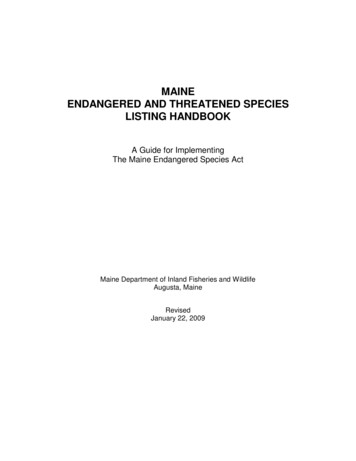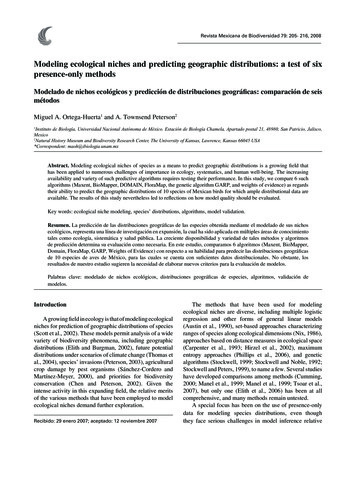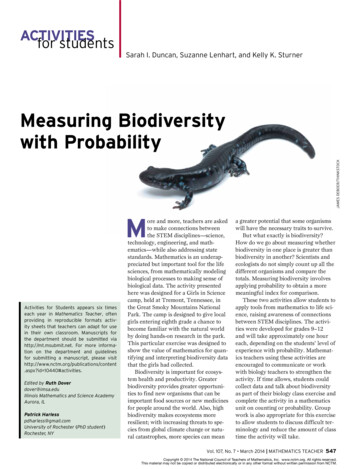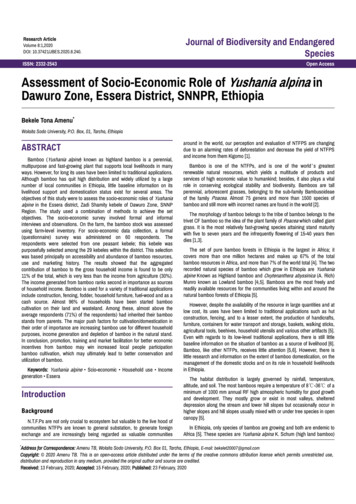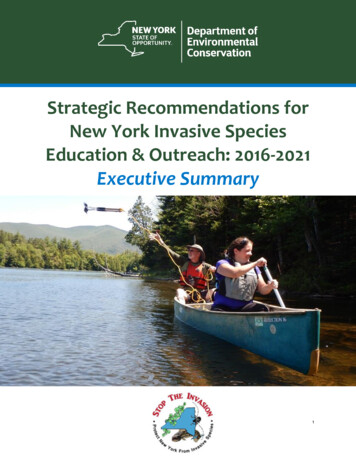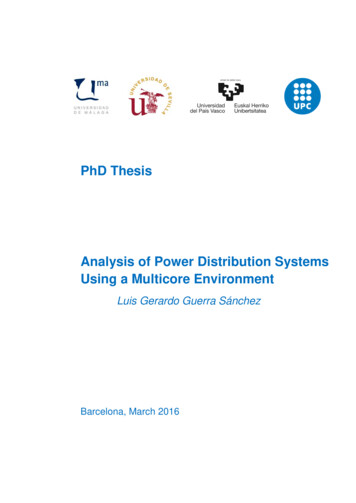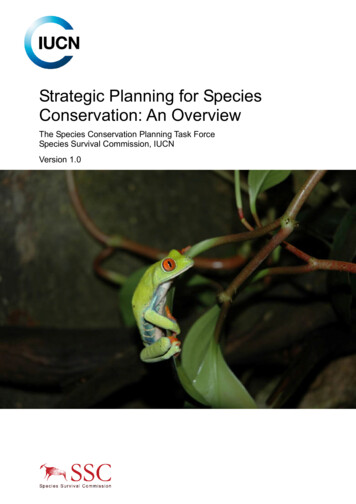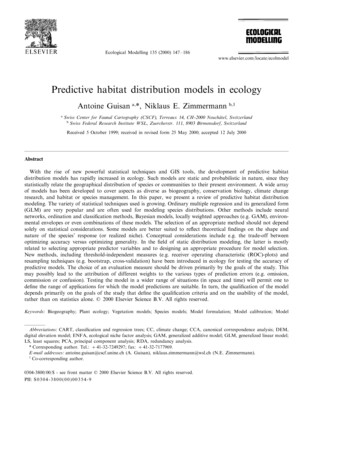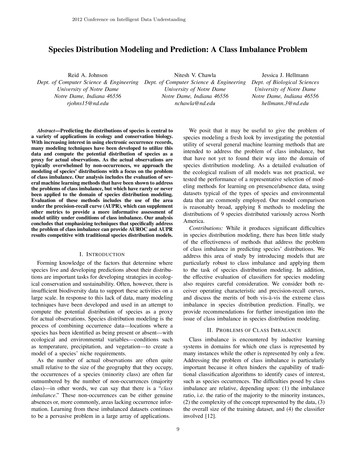
Transcription
2012 Conference on Intelligent Data UnderstandingSpecies Distribution Modeling and Prediction: A Class Imbalance ProblemNitesh V. ChawlaJessica J. HellmannReid A. JohnsonDept. of Computer Science & Engineering Dept. of Computer Science & Engineering Dept. of Biological SciencesUniversity of Notre DameUniversity of Notre DameUniversity of Notre DameNotre Dame, Indiana 46556Notre Dame, Indiana 46556Notre Dame, Indiana uWe posit that it may be useful to give the problem ofspecies modeling a fresh look by investigating the potentialutility of several general machine learning methods that areintended to address the problem of class imbalance, butthat have not yet to found their way into the domain ofspecies distribution modeling. As a detailed evaluation ofthe ecological realism of all models was not practical, wetested the performance of a representative selection of modeling methods for learning on presence/absence data, usingdatasets typical of the types of species and environmentaldata that are commonly employed. Our model comparisonis reasonably broad, applying 8 methods to modeling thedistributions of 9 species distributed variously across NorthAmerica.Contributions: While it produces significant difficultiesin species distribution modeling, there has been little studyof the effectiveness of methods that address the problemof class imbalance in predicting species’ distributions. Weaddress this area of study by introducing models that areparticularly robust to class imbalance and applying themto the task of species distribution modeling. In addition,the effective evaluation of classifiers for species modelingalso requires careful consideration. We consider both receiver operating characteristic and precision-recall curves,and discuss the merits of both vis-à-vis the extreme classimbalance in species distribution prediction. Finally, weprovide recommendations for further investigation into theissue of class imbalance in species distribution modeling.Abstract—Predicting the distributions of species is central toa variety of applications in ecology and conservation biology.With increasing interest in using electronic occurrence records,many modeling techniques have been developed to utilize thisdata and compute the potential distribution of species as aproxy for actual observations. As the actual observations aretypically overwhelmed by non-occurrences, we approach themodeling of species’ distributions with a focus on the problemof class imbalance. Our analysis includes the evaluation of several machine learning methods that have been shown to addressthe problems of class imbalance, but which have rarely or neverbeen applied to the domain of species distribution modeling.Evaluation of these methods includes the use of the areaunder the precision-recall curve (AUPR), which can supplementother metrics to provide a more informative assessment ofmodel utility under conditions of class imbalance. Our analysisconcludes that emphasizing techniques that specifically addressthe problem of class imbalance can provide AUROC and AUPRresults competitive with traditional species distribution models.I. I NTRODUCTIONForming knowledge of the factors that determine wherespecies live and developing predictions about their distributions are important tasks for developing strategies in ecological conservation and sustainability. Often, however, there isinsufficient biodiversity data to support these activities on alarge scale. In response to this lack of data, many modelingtechniques have been developed and used in an attempt tocompute the potential distribution of species as a proxyfor actual observations. Species distribution modeling is theprocess of combining occurrence data—locations where aspecies has been identified as being present or absent—withecological and environmental variables—conditions suchas temperature, precipitation, and vegetation—to create amodel of a species’ niche requirements.As the number of actual observations are often quitesmall relative to the size of the geography that they occupy,the occurrences of a species (minority class) are often faroutnumbered by the number of non-occurrences (majorityclass)—in other words, we can say that there is a “classimbalance.” These non-occurrences can be either genuineabsences or, more commonly, areas lacking occurrence information. Learning from these imbalanced datasets continuesto be a pervasive problem in a large array of applications.II. P ROBLEMS OF C LASS I MBALANCEClass imbalance is encountered by inductive learningsystems in domains for which one class is represented bymany instances while the other is represented by only a few.Addressing the problem of class imbalance is particularlyimportant because it often hinders the capability of traditional classification algorithms to identify cases of interest,such as species occurrences. The difficulties posed by classimbalance are relative, depending upon: (1) the imbalanceratio, i.e. the ratio of the majority to the minority instances,(2) the complexity of the concept represented by the data, (3)the overall size of the training dataset, and (4) the classifierinvolved [12].9
2012 Conference on Intelligent Data UnderstandingTable I. Species occurrence information. The instancescolumn corresponds to the number of species occurrencesused in the study, while the imbalance column denotes theratio of the total number of points in the study area to thenumber of instances.In a typical supervised learning scenario, classifiers aretrained and ranked by any of a large number of evaluationmetrics. This situation is complicated by the presence ofimbalance in the data. Not only can different evaluationmetrics give conflicting rankings, but they may react to thepresence of various levels of class imbalance in differentways. That is, not only can class imbalance make it difficultto develop effective classifiers, but it can make it difficultto develop evaluation metrics that effectively evaluate theperformance of those classifiers.In light of these problems, we focus on several evaluation metrics that have been shown to be robust to theeffects of imbalance. The area under the Receiver OperatingCharacteristic curve (AUROC) is the de facto standard forperformance in the class imbalance literature, while correlation (CORR) is frequently used in the evaluation of speciesdistribution models. Our evaluations also include the areaunder the Precision-Recall curve (AUPR), a metric that wesuggest may be useful for evaluating species models. Thesethree metrics are commonly used as single representativenumbers to describe classifier 13:113:145:16:124:19:1167:1The species studied are all small- to medium-sized birdsbelonging to the Vireo genus. Our study focuses on ninespecies prevalent in the Northeastern United States.III. M ATERIAL AND M ETHODSB. Modeling MethodsA. Data for modelingEight models were used, some being algorithms trained inmore than one way. Each model requires the use of presenceand absence points. All background (i.e., non-presence)points were used as absences and all occurrence points wereused as presences; accordingly, the models were developedusing all of the points provided, each point distinguished aseither present or absent.The presence data were divided into random partitions:in each partition, 70% of the occurrence localities wererandomly selected for the training set, while the remaining30% were set aside for testing. This procedure was repeatedten times to create ten random 70/30 splits for each dataset.The models were then run on each of these datasets. Severalstatistics were computed and averaged over the ten runs foreach model.On each of these runs, we evaluated eight models: unpruned C4.5 decision trees (C4.5) [17], Classification andRegression Trees (CART) [1], logistic regression (LR), maximum entropy (MAXENT) [15], Naı̈ve Bayes (NB) (withkernel density estimation), Hellinger Distance decision trees(HDDT) [4], Random Forests (RF) [2], and Random Forestswith SMOTE applied (RF-SMT) [3]. Each model can beconsidered to use some rules or mathematical algorithmsto define the ecological niche of the species based on thedistribution of the species records in the environmentalspace. Once the predicted species niche is defined, theprojection of the model into the geographical space producesa predictive map. MAXENT is a method based specificallyon the concept of the ecological niche, while the othermethods used have proven useful in other domains. Eachmethod will be briefly explained in turn.The environmental and species data used in our experiments were selected with the intent of facilitating usefulcomparisons while providing a reasonably wide scope ofevaluation. The environmental data provides several bioclimatic variables over an environmentally heterogeneous studyarea. The selected species provide a range of class imbalanceand spatial variation.The environmental coverages constitute a North Americangrid with 10 arc-minute square cells. The coverages consistof 18 bioclimatic variables derived from the monthly temperature and rainfall values during the period 1950 to 2000.Each coverage is defined over a 302 x 391 grid, of which67,570 points have data for all coverages [11].As supplied, the environmental data required considerable grooming to generate datasets of consistent quality.Environmental coverages were altered so that projections,grid cell size, and spatial extent were consistent across allvariables. We note that a limitation of our experiments aretheir restriction to a single spatial extent and grid cell size;it is a topic of current interest to evaluate how altering thesefactors might affect the various models studied, though alsobeyond the scope of this work.All of our species data pertains to North America and isderived from the Global Biodiversity Information Facility(GBIF), an international government-managed data portalestablished to encourage free and open access to biodiversitydata via the Internet. Some species data had more than oneoccurrence per grid cell, either because of repeat observations or sites in close proximity to each other; these duplicateoccurrences were reduced to one record per grid cell.10
2012 Conference on Intelligent Data UnderstandingWe used several decision trees in our experiments. Adecision tree is a tree in which each branch node represents achoice between a number of alternative properties, whereineach leaf node represents a classification or decision. Theimportant function to consider when building a decision treeis known as the splitting criterion, which defines how datashould be split in order to maximize performance.C4.5 builds decision trees from a set of training data usingthe concept of information entropy, a measure of uncertainty,to define the splitting criteria [17].CART uses the Gini index, a measure of how often arandomly chosen element from the set would be incorrectlylabeled if it were randomly labeled according to the distribution of labels in the subset [1]. While C4.5 and CARTcan be effective on datasets that have been sampled, theyare considered to be “skew sensitive” [10]; that is, themethods can become biased as the degree of class imbalanceincreases.HDDT, another decision tree, uses the measure ofHellinger distance to decide between alternative properties,a measure that quantifies the similarity between two probability distributions [4][19]. By using this measure, HDDTcapitalizes on the importance of designing a decision treesplitting criterion that captures the divergence in distributions while being skew-insensitive [5].Random Forest is an ensemble classifier that consists ofmany decision trees and outputs the class that is the mode ofthe classes output by individual trees [2]. In our experiments,we ran two implementations of Random Forest: one simplyused Random Forest with the generated training sets, theother used Random Forest with SMOTE applied to thetraining sets.SMOTE is an over-sampling approach in which the minority class is over-sampled by creating “synthetic” examples.This is done by taking each minority class sample andintroducing the synthetic examples along the line segmentsjoining any/all of the nearest neighbors to minority class.SMOTE has proven effective at achieving better classifierperformance than only under-sampling the majority class inimbalanced datasets [3].Logistic regression is a type of regression analysis usedfor predicting the outcome of a categorical variable (a vari-able that can take on a limited number of categories) basedon one or more predictor variables. In logistic regression,the regression coefficients represent the rate of change inthe logit—the logarithm of the odds ratio—for each unitchange in the predictor.Naı̈ve Bayes is a simple probabilistic classifier based onapplying Bayes’ theorem with strong (naı̈ve) independenceassumptions. In general terms, a naı̈ve Bayes classifierassumes that, given the class, the presence or absence ofa particular feature is unrelated to the presence or absenceof any other feature. Despite these strong assumptions,Naı̈ve Bayes often performs quite well, especially as it onlyrequires a relatively small amount of training data to estimatethe parameters necessary for classification [18].MAXENT estimates species’ distributions by finding thedistribution of maximum entropy (i.e. closest to uniform)subject to the constraint that the expected value of eachenvironmental variable (or its transform and/or interactions)under this estimated distribution matches its empirical average). MAXENT is a leading model that has been shown toperform well in predicting species distributions, as evaluatedby [9].C. Metric DescriptionsThe evaluation was focused on each model’s predictiveperformance on the testing sets. Performance was evaluatedusing three statistics: the area under the Receiver OperatingCharacteristic curve (AUROC), the area under the PrecisionRecall curve (AUPR), and correlation (CORR). AUROC has been used extensively in the species’distribution modeling literature, and provides a scalarmeasure of the ability of a model to discriminatebetween sites where a species is present versus thosewhere it is absent [8]. If one picks a random positiveexample and a random negative example, then the areaunder the curve is the probability that the classifiercorrectly orders the two points (with random orderingin the case of ties). Accordingly, a perfect classifier hasan AUROC of 1, while a score of 0.5 implies predictivediscrimination that is no better than a random guess.The use of the AUROC metric with presence-only dataindicates that we interpret all grid cells with no occurrence localities as “negative examples”, even if theysupport good environmental conditions for the species.Therefore, in practice, the maximum AUROC is lessthan one, and is smaller for wider-ranging species.However, AUROC can present an overly optimisticview of an algorithm’s performance if there is a largeskew in the class distribution [6]. In our experiments,AUROC was calculated using the trapezoid rule. AUPR provides a scalar measure of classifier performance by varying the decision threshold on probability estimations or scores, representing the degree towhich positive examples are separated from negativeTable II. Modeling methods implemented.MethodClass of model and explanationC4.5CARTLRMAXENTNBHDDTRFRF-SMTdecision tree using information gaindecision tree using Gini coefficientlogistic regressionmaximum entropynaı̈ve Bayes classifierdecision tree using Hellinger distancedecision tree ensembledecision tree ensemble with SMOTESoftwareWekaWekaWekaMaxentWekaC WekaWeka11
2012 Conference on Intelligent Data Understandingexamples. AUPR captures the innate trade-off betweensuccessfully identifying positive class instances andremaining parsimonious in producing positive classpredictions. AUPR is a skew-sensitive metric and isgreatly affected by imbalances in the data. Thus whendealing with highly skewed datasets, AUPR can providea especially informative picture of an algorithm’s performance [6]. In the context of species modeling, AUPRsignificantly penalizes incorrect predictions of speciesoccurrence (false positives). This benefits models thatdo not over-predict a species’ range, but may overpenalize models that predict occurrences in locationswhere a species is assumed absent due to lack ofoccurrence information. CORR, the correlation between the observation in theoccurrence dataset (a dichotomous variable) and theprediction, is known as the point biserial correlation,and can be computed as a Pearson correlation coefficient [20]. It is similar to AUROC, but also providesadditional information, taking into account how farthe prediction varies from the observation. This givesfurther insight into the distribution of the predictions.Typically, AUROC is used in the species distributionliterature for evaluation, while AUPR is generally omitted.However, by using both the AUPR and the AUROC metricstogether, we gain a fuller characterization of the predictionsthan using either alone. For example, the AUPR curvereflects whether the first few occurrence predictions at thetop of the prediction list are correct; the ROC curve does notprovide this information. Additionally, AUROC and AUPRhave different strengths: AUROC can be overly optimisticin cases of class imbalance while making fewer assumptionsabout misclassification costs than other metrics [7][16],while AUPR can be particularly useful when dealing withhighly imbalanced datasets [13][14].Table IV summarizes model performance on the AUPRmetric. HDDT obtained the highest AUPR on 7 of the9 species datasets, while MAXENT obtained the highestAUPR on the remaining 2. On average, HDDT received a30% higher AUPR than MAXENT. The highest AUPR onthe V. vicinior dataset—the most imbalanced dataset usedfor evaluation—was obtained by MAXENT. NB producedthe lowest AUPR performance on all of the datasets usedfor evaluation.Table V summarizes model performance on the CORRmetric. HDDT obtained the highest CORR on 4 of the 9datasets. HDDT also obtained the highest AUPR on eachof these datasets. LR received the highest CORR on 2; andMAXENT, C4.5, and RF each obtained the highest CORRon a single dataset. HDDT obtained the highest CORR onaverage, followed by MAXENT and C4.5. NB demonstratedthe lowest CORR performance on all of the datasets.IV. R ESULTSThough not dominant on any given species dataset, HDDTwas shown in our evaluations to be the most stable classifier according to AUROC. That is, its average AUROCmeasure was the highest of all methods evaluated. MAXENT performance tended to perform best on datasets withrelatively high levels of imbalance, while C4.5 performbest on datasets with relatively low levels of imbalance.However, MAXENT performance was significantly lowerthan HDDT on several datasets with low imbalance, whileC4.5 showed similar characteristics on several datasets withhigh imbalance. According, though it never exceeded thehighest performer on any given dataset, HDDT producedthe most balanced performance across all of the datasets,performing well on datasets with both relatively high andrelatively low imbalance.As our results show, HDDT is handily the dominantperformer with respect to AUPR. It outperforms the othermethods—often by large amounts—on 7 of the 9 datasets,B. Distribution MapsTo display modeled results geographically, we show distributions predicted with several modeling methods, as shownin Figures 1 and 2. These maps illustrate variation inmodel predictions among techniques. The most obviousdifferences are in the proportion of the region that appears to be predicted most suitable for the species. Theresultant distributions suggest a natural division into twogroups: models that produce wide-ranging predictions, suchas MAXENT and LR, and models that produce narrow,point-like predictions, such as HDDT and C4.5.V. D ISCUSSIONAssessments of the model performance using AUROC,AUPR, and CORR indicate that the methods studied significantly differed in their performance.A. Comparison of MethodsA. Performance MetricsModel performance was evaluated using AUROC, AUPR,and CORR metrics.Table III summarizes model performance on the AUROCmetric. MAXENT obtained the highest AUROC on 4 ofthe 9 species datasets used for evaluation. These 4 datasetsinclude the three most imbalanced datasets (fewest occurrences). C4.5 obtained the highest AUROC on the other 5species datasets. Though it never obtains the highest AUROC performance on a given dataset, HDDT demonstratedthe highest AUROC performance when averaged over all ofthe datasets, followed by C4.5 and MAXENT. The averageAUROC of the top 4 models differs by less than 5%.HDDT averages about 15% higher AUROC performancethan CART, which produced the lowest average AUROCof the models evaluated.12
2012 Conference on Intelligent Data UnderstandingTable III. Mean AUROC per iusviciniorAverageMean 0.9160.9120.8920.8780.8100.8000.781Table IV. Mean AUPR per iusviciniorAverageMean .3910.2500.2880.1000.2560.2300.161Table V. Mean CORR per iusviciniorAverageMean .4140.3860.3940.0880.3710.3450.22513
2012 Conference on Intelligent Data UnderstandingFigure 1. V. olivaceus distribution predicted by MAXENT (left) and HDDT (right).Figure 2. V. olivaceus distribution predicted by the other six evaluated models: C4.5 (top left), LR (top center), NB (topright), RF (bottom left), RF-SMT (bottom center), and CART (bottom right).and boasts the highest average AUPR by a large margin.The dominant performance of HDDT with respect to AUPRis particularly important, as AUPR may a useful metric for evaluating imbalanced species distribution models.In particular, the AUPR scores reflects negatively uponclassifiers that generate an imbalance between correctlypredicted occurrences—true positives—and incorrectly predicted occurrences—false positives. When dealing with imbalanced datasets, classifiers that are sensitive to this imbalance may capture true positives at the cost of a proportionally high number of false positives, resulting in a lowerAUPR score than a classifier that attempts to balance bothmeasures. In general, if we consider only the top-k classifierpredictions, we still find that MAXENT generates more falsepositive predictions than HDDT, resulting in a consistentlylower AUPR score.HDDT also performs well with respect to the CORRmetric. While both AUROC and AUPR performance onindividual datasets tended to be dominated by one or afew models, several different models dominate CORR ondifferent datasets. That said, HDDT produced the highestCORR on 4 of the 9 datasets, and also demonstrated thehighest average CORR.Though the success that HDDT demonstrates with boththe AUPR and CORR metrics suggests that the model iscapturing useful information regarding the minority class, itis important that the method produces distribution maps thatproperly model the species in question.14
2012 Conference on Intelligent Data UnderstandingThe distributions produced by MAXENT and HDDT arestrikingly different. HDDT is extremely conservative in itspredictions, generally giving high probabilities only to asmall region of the study area. This results in strong predictions only around individual occurrence localities. Thismay also explain its high AUPR performance, as by makingfewer predictions than MAXENT, HDDT is less likely toproduce false positive predictions, which are assigned agreater penalty by AUPR than by AUROC. In contrast,MAXENT is less particular, covering a large region of thestudy area with moderate probabilities.Although the difference in predicted area might stem frompredictions that are scaled in different ways, the variationin AUROC suggests actual differences between the methods. The conservative predictions allow HDDT to properlyexclude regions of the Great Lakes, which MAXENT includes in its prediction. Additionally, as MAXENT tendsto produce more false positive predictions than HDDT, itultimately receives a lower AUPR score. However, as thereis ambiguity as to which points represent true absence (andwhich represent assumed absence), we conjecture that AUPRmay underpredict the true classifier performance.the data, it is possible that a poorly fitted model (overestimating or underestimating all the predictions) has a gooddiscriminatory power. It is also possible that a well-fittedmodel has poor discrimination if, for example, probabilitiesfor presences are only moderately higher than those forabsences. In this way, it is possible for C4.5, which maynot properly model any imbalance or incompleteness in thedistribution, to nonetheless discriminate between presencesand absences relatively well. In contrast, MAXENT, whichattempts to model the occurrence localities as samples ina statistical distribution, may successfully model the imbalance and incompleteness of a species distribution whileproviding less discriminatory power. That is, it models thedistribution more accurately, but is less accurate at properlydistinguishing between points in that distribution.This provides evidence of a fundamental drawback ofAUROC in this domain: that it can present an overlyoptimistic view of an algorithm’s performance if there isa large skew in the class distribution. As species data arealmost universally imbalanced, due typically to a relativelylarge study area with a comparatively few presence localities and incomplete sampling, this limitation of the metricis invariably extenuated. To partly address this issue, wepropose the use of the AUPR metric to supplement theuse of AUROC. AUPR can better capture this imbalance,allowing it to provide a more informative picture of analgorithm’s performance under extreme imbalance. HDDTgenerally sees the highest boost in performance on datasetswith less imbalance.B. Broad PatternsBoth MAXENT and HDDT performed relatively wellaccording to all three evaluation measures. C4.5 and LRdemonstrated slightly lower performance, followed by RF,RF-SMT, and CART. NB showed intermediate performancefor AUROC, but the lowest AUPR and CORR performance.For most methods, predictive performance did not varyconsistently with number of presence records available formodeling.In general, we find that C4.5 tended to show the best AUROC performance on the datasets with the most occurrencesper area (and hence the least imbalanced). However, whenevaluated with respect to AUPR, C4.5 tended to performpoorly. Similarly, NB performed relatively well accordingto AUROC, yet was among the lowest performers withrespect to AUPR and CORR. In contrast, the models thatperformed well according to AUPR also tended to performwell according to AUROC and CORR.We find that, altogether, MAXENT and HDDT tend tooutperform the other methods, though C4.5 occasionallyboasts the highest AUROC. However, C4.5 tended to produce a high AUROC on datasets with low class imbalance,indicating that C4.5 is significantly skew-sensitive. Conversely, MAXENT demonstrated the highest AUROC fornearly all of the small, significantly imbalanced datasets.HDDT produced the most stable performance, when averaged over all of the datasets.As AUROC is a discrimination metric that represents thelikelihood that a presence will have a higher predicted valuethan an absence regardless of how well the predictions fitVI. C ONCLUSIONSWe can draw two major conclusions from our results.First, the precision-recall metric can be a useful tool forevaluating species distribution models. It is a skew-sensitivemetric that appears to have discriminatory power, and cancomplement the prevalent use of AUROC. Second, theHDDT model, which has been effective when used onimbalanced datasets in other domains, generally modeledspecies with performance competitive with MAXENT, anestablished species distribution model. Though HDDT originated in another discipline and has had little exposure inecological analysis, it appears to offer considerable promiseacross a much broader range of species data, providing anexciting avenue for future research.Class imbalance continues to be a significant problemfor species distribution modeling, as it pertains to boththe development and evaluation of these models. ThoughAUROC serves as
with SMOTE applied (RF-SMT) [3]. Each model can be considered to use some rules or mathematical algorithms to dene the ecological niche of the species based on the distribution of the species records in the environmental space. Once the predicted species niche is dened, the projection of the model into the geographical space produces a .

